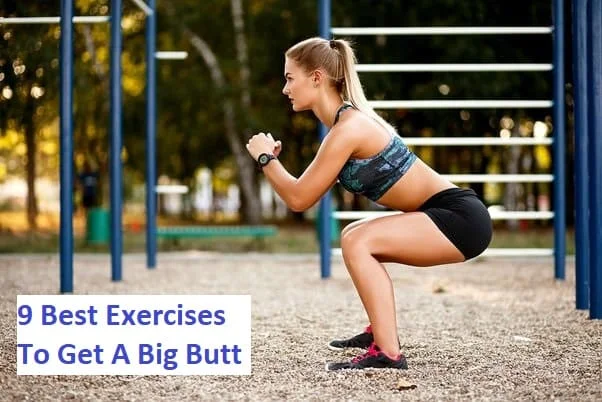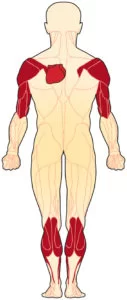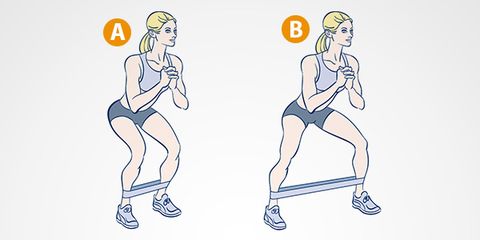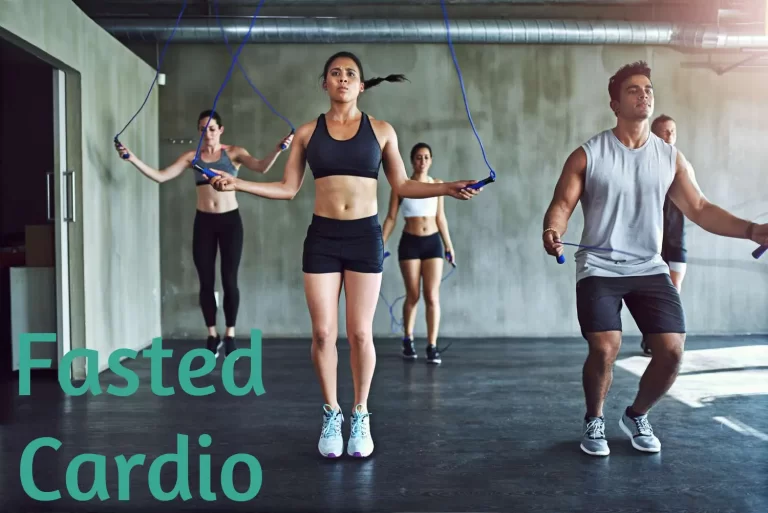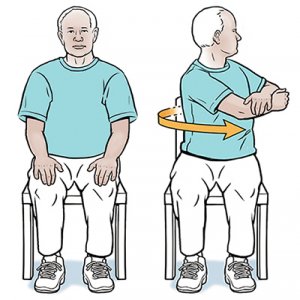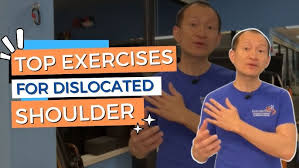9 Best Exercises To Get A Big Butt
Introduction
The muscles that make up the butt and contribute to its rounded appearance are the glutes. A flat butt can, however, be caused by heredity or problems with the glutes’ function.
With the correct glute workouts, such as walking lunges and hip thrusts, glutes can become stronger and rounder. Continue reading to find out more about how to elevate a flat butt.
Why do people get flat butts?
You have some power over how your butt looks. The primary factor that determines your butt’s size and shape is genetics. That’s because a person’s level of muscle mass may be influenced by their genes. That’s because a person’s level of muscle mass may be influenced by their genes.
As you age, your muscles vary, and this can cause your glutes to flatten. As you become older, you could lose muscular contraction, tone, and tissue.
The form of your butt might be influenced by how you’ve used your glutes throughout your life. Therefore, compared to someone who may not have participated in any sports as a youngster, someone who was a gymnast as a child may have better-developed glutes or have an easier time toning the glutes as they become older.
Because of gluteal amnesia or dormant butt syndrome, some people may occasionally have a flat butt. When the glute muscles are not active or functional at all, the condition occurs.
Because of gluteal amnesia or dormant butt syndrome, some people may occasionally have a flat butt. When the glute muscles are not active or functional at all, the condition occurs.
You can nonetheless enhance your assets even though you can’t necessarily change your booty’s natural curvature. Plus, having a powerful, toned butt has a lot of advantages. In the following domains, having powerful glutes might be beneficial:
- Improving athletic performance
- Injury avoidance
- Typical walking techniques
- Pain reduction
- Make these changes to your exercise and lifestyle to elevate your butt and quicken your results.
There are a few workouts you may do at home to increase your butt size
Glute bridge
The glute bridge is a safe workout for beginners that isolates and strengthens your glute muscles, hamstrings, and core while also boosting hip stability.
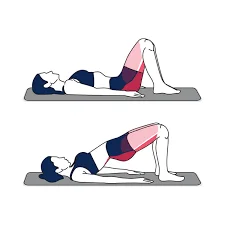
- You should be lying on your back with your legs bent, and feet resting on the ground. With your hands flat on the ground, position your arms at your sides.
- Firmly press your feet, become involved in your glutes, and raise your hips off the floor. Starting at your shoulders to your knees, your body ought to be in a straight line.
- Five seconds of pause at the top are followed by a leisurely descent to the starting point.
- Finish three sets of 15 repetitions.
Jumping squats
Your heart rate will increase as a result of this intense plyometric workout, which also works your glutes, hips, quadriceps, hamstrings, and calves.
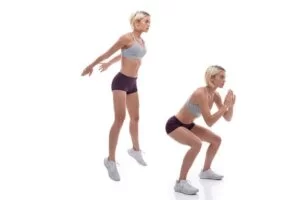
Before doing jump squats, speak with a physical therapist if you have any knee, ankle, hip, or balance difficulties.
- With your arms by your sides and your feet slightly wider than shoulder-width apart, squat to a standing posture.
- Lower your body once so that your thighs are parallel to your knees. Put your hands together and extend your arms in front of you as you squat.
- Lift your body off the ground and upward. Try to elevate your feet at least three inches off the ground. For assistance with movement, extend your arms.
- Repeat that by squatting again with slightly bent knees.
- Finish three sets of 10–15 repetitions.
Single-leg glute bridge
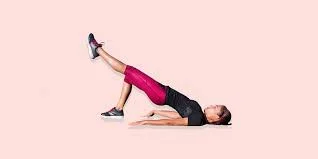
- Your body should make a straight line from your shoulders to your knees by resting your upper back on the floor, standing with your feet hip-width apart, and bending your knees at a 90-degree angle.
- Your beginning position is to tighten your glutes and arch your hips.
- Drive through your heel to ascend once again, pause for 3 seconds, and then gradually descend. Repeat.
Hip abduction
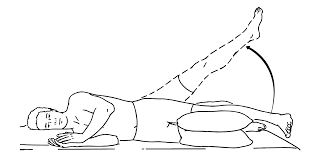
- To support your upper body while resting on your side, place your top arm in the direction of your chest.
- Raise your top leg towards the ceiling while maintaining the most straight and engaged upper body and core you can.
- Controlled descent back down is required. Repeat.
Side lunge
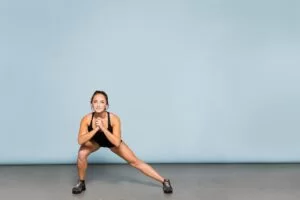
- Engage your core and lunge laterally while maintaining your upper back flat as you stand at the top of the mat with your feet together.
- Repeat by driving into the heel of your lunging foot.
Walking lunge with weights
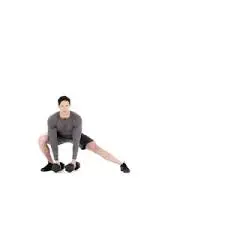
- The walking lunge is an ideal exercise for building, strengthening, and toning glutes, quadriceps and improving balance.
- If you have any knee, ankle, or hip issues, consult a physical therapist before using this technique.
- You should have a dumbbell in each hand and your arms should be at your sides.
- Place your feet approximately hip distance apart and stand. With your left foot, advance forward roughly two steps.
- Make sure your left knee is parallel to the floor by bending it downward. The forward lunge stance looks like this.
- Take a moment to pause and hold this posture.
- Then, step forward on your rear leg (which should be your right), and repeat the lunge leading motion with this leg.
- For 20 repetitions (10 for each leg), alternate the legs while performing this walking lunge pattern.
- finished two sets of 20 repetitions.
In-and-Out squats
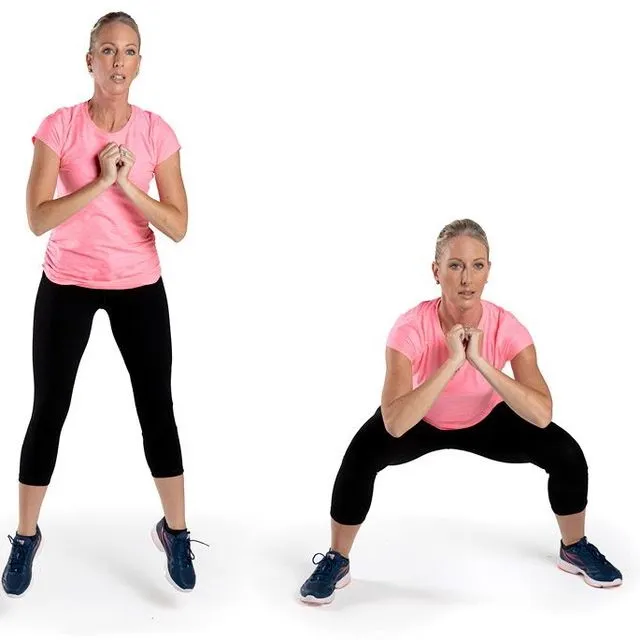
- Keeping your upper body straight and your knees tracking over your toes, leap out into a deep lunge while standing with your feet together.
- Immediately after returning to standing, go again into a deep squat. Repeat.
Sumo squats
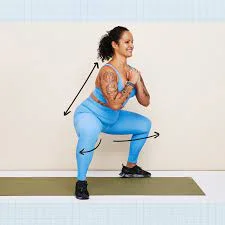
- Set up in a squat stance with your feet wider than hip-width apart and your knees tracking over your toes. As you come down, if it helps maintain your upper body upright, raise your arms aloft.
- Repeat while standing back up.
Single-leg deadlift
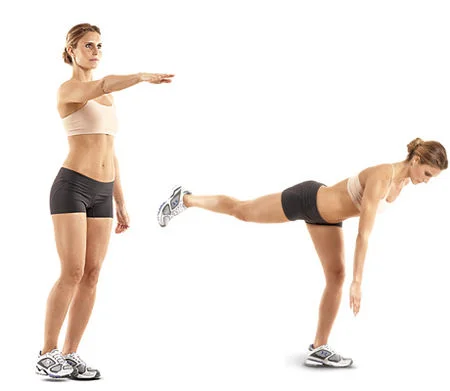
- The single-leg deadlift is an advanced to expert exercise that strengthens your hamstrings and glutes. Additionally, your balance and fundamental stability are put to the test.
- In each hand, hold a dumbbell. In thighs, keep your hands.
- Standing with a small knee bend and your weight on your right side. Put your core muscles to work.
- Start the motion by extending at the hip. Bending with palms facing each other, let the weights drop to the floor in front of you. As your left leg straightens out and your right foot stays on the floor, your body will drop towards the ground.
- When you can bring your left leg as near to parallel to the floor as you can without tipping over, hinge slowly.
- Return your leg gently to its initial position.
- Perform 3 sets of 15 sets of reps on each leg.
Nutrition
When it comes to gaining more butt, diet is equally as vital as exercise. For muscles to grow, a balanced diet that contains lean proteins, complex carbs, and healthy fats is necessary. Ensure you are consuming enough calories to sustain your exercise as well. Use an online calorie counter or see a nutritionist to estimate your daily caloric requirements.
Rest
Remember to take some rest, and prevent being hurt. Many patients with butt discomfort, particularly at the top of the butt around their sacroiliac joints. Additionally, we observe patients arriving with ischial bursitis (inflammation in the butt’s lower region) and tendonitis such as gluteal medius tendinopathy.
Supplements
Supplements might be a useful addition to your regimen even if they are not absolutely required for growing your butt. In particular, protein supplements can boost muscle growth and help you reach your daily protein requirements. Moreover, glutamine and creatine might help you maximize the effectiveness of your workouts. Before ingesting any supplements, be sure to consult a healthcare provider.
Overview
Age, genetics, glute usage, or issues with glute activation can all contribute to flat butts. Fortunately, you may incorporate exercises into your routine to help develop larger, stronger glutes. These possibilities include unilateral motions, stretching, general glute-focused workouts, and aerobic routines specifically targeted at the glutes.
FAQs
Can squats increase bum size?
Does Squatting Increase Butt Size?
The perfect exercise for developing and toning out glutes is a squat. However, if you’re not seeing any progress or experiencing gluteal discomfort, your strategy has to be changed. Consider using squats in your normal exercise program if you want to develop bigger, stronger glutes.
What makes your thighs and bum bigger?
You must develop your thigh and glute muscles if you want to be thick. The gluteus maximus, quadriceps, and hamstrings are these muscles. These muscles, which give the lower body its thickness, must be well-developed. So if you want to develop thick, doing resistance workouts like squats and deadlifts is essential.
Does doing 100 squats a day work?
You may build muscle endurance and growth, particularly in your quads, by performing 100 squats every day for a month. However, if you’re a seasoned exerciser, you might not see any noticeable improvements. While losing weight is a possibility, you also need to be in a calorie deficit in order to do it.
What are the disadvantages of squats?
Squat cons
Your shoulders could become fatigued if you’re gripping a large barbell. It’s possible to get motionless at the bottom of a squat and not be able to stand back up again. If your knees go too far in or out during the workout, you run the danger of hurting them. You might require a spotter.
Will squats increase thigh size?
Squats make your legs appear thicker overall because they grow the size of your leg muscles (particularly your quadriceps, hamstrings, and glutes) without significantly reducing body fat. Stop squatting if you want to reduce the size of your leg muscles.
References
- Exercises and Strategies for a Bigger, Firmer Butt. Healthline. https://www.healthline.com/health/how-to-get-a-bigger-butt
- Exercises, routines, and advice that genuinely works for a bigger bum. Women’s Health. https://www.womenshealthmag.com/uk/fitness/workouts/a708457/exercise-for-a-bigger-butt/
- Top 5 Exercises for Building Muscle in the Butt. Surrey Physio. https://www.surreyphysio.co.uk/top-5/top-5-exercises-to-get-a-bigger-butt/
- Flat Butt: Causes, Tips, Exercises. Health. https://www.health.com/fitness/flat-butt-exercise-tips

